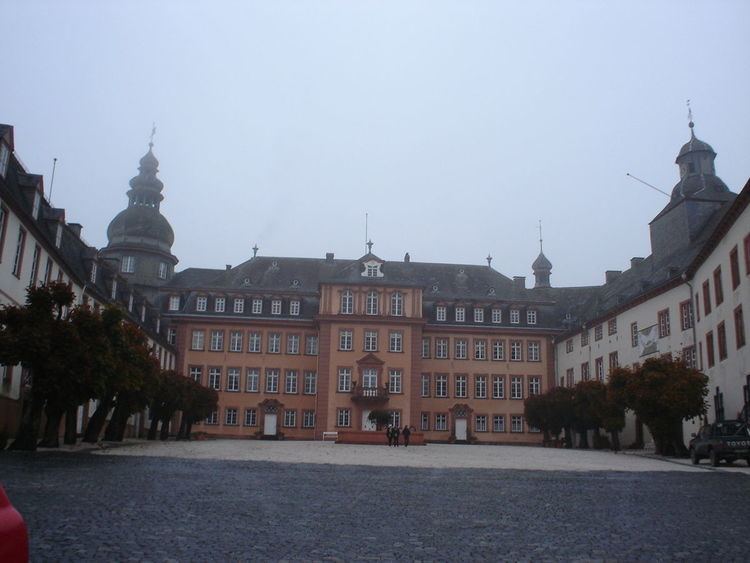Government Principality Preceded by Succeeded by Date dissolved 1806 | Languages Westphalian Founded 1607 | |
 | ||
Sayn-Wittgenstein-Berleburg was one of several imperial counties ruled by the House of Sayn-Wittgenstein.
Contents
- Counts of Sayn Wittgenstein Berleburg 16071792
- Princes of Sayn Wittgenstein Berleburg since 1792
- Line of succession
- References
Most of the former county is located in the present district of Siegen-Wittgenstein (in the modern state of North Rhine-Westphalia), Germany. Its seat was the town and palace in Berleburg (now Bad Berleburg).
Sayn-Wittgenstein-Berleburg was a partition of Sayn-Wittgenstein in the 16th century; the southern and more-developed portion was the County of Sayn-Wittgenstein-Wittgenstein with its seat Laaspe (now Bad Laasphe). Wittgenstein-Berleburg was raised from a county to a principality (Reichsfürstentum) in 1792, and was mediatised to the Grand Duchy of Hesse in 1806 before being annexed to Prussia in 1816.
Counts of Sayn-Wittgenstein-Berleburg (1607–1792)
Princes of Sayn-Wittgenstein-Berleburg (since 1792)
Line of succession
Four branches of the princely House of Sayn were extant at the beginning of the 20th century, each having inherited its own appanage while the family enjoyed Imperial immediacy as vassals of the Holy Roman Empire. In order of seniority of legitimate descent from their progenitor, Ludwig I, Count of Sayn-Wittgenstein (1532-1605), they were the:
- Princes (Fürsten) zu Sayn-Wittgenstein-Berleburg, descended from Count Georg (1565-1631)
- Princes (Fürsten) zu Sayn-Wittgenstein-Sayn, descended from Count Christian Ludwig (1725-1797)
- Counts zu Sayn-Wittgenstein-Berleburg, descended from Count Georg Ernst (1735-1792)
- Princes (Fürsten) zu Sayn-Wittgenstein-Hohenstein, descended from Count Ludwig (1571-1634)
Some of these lines further splintered into cadet branches, dynastic and non-dynastic, the latter including families whose right to the princely title was recognized by the Russian, Prussian or Bavarian monarchies, whereas other morganatic branches used lesser titles in Germany.
On the death of Ludwig, 3rd Prince of Sayn-Wittgenstein-Hohenstein in 1912, the eldest of his three sons, Hereditary Prince August (1868-1947), became 4th Prince of Sayn-Wittgenstein-Hohenstein and head of the third branch of the House of Sayn. Being a childless bachelor, the elder of whose two younger brothers, Georg (1873-1960), had married morganatically, while the younger, Wilhelm (1877-1958), was 49 and yet unmarried, August preserved the name and heritage of his branch of the House of Sayn by adopting Prince Christian Heinrich {Christian Heinrich Prinz zu Sayn-Wittgenstein-Berleburg} (1908-1953) of the Berleburg line. He was the second son of the late head of the entire House of Sayn, Richard, 4th Prince of Sayn-Wittgenstein-Berleburg (1882-1925), whose eldest son Gustav Albrecht, 5th Prince of Sayn-Wittgenstein-Berleburg (1907-1944), had inherited the senior line's fortune and position.
In November 1960, Christian Heinrich, being the divorced father of three daughters by his dynastic marriage to Countess Beatrix von Bismarck-Schönhausen {Beatrix Grafin von Bismarck-Schönhausen} (1921-2006), married Princess Dagmar {Dagmar Prinzessin zu Sayn-Wittgenstein-Hohenstein} (1919-2002), elder daughter of his adopted father's younger brother, Georg, who died seven months before the wedding. As Georg's children by his morganatic wife, Marie Rühm, (created Baroness von Freusburg by the reigning Prince of Lippe in 1916) had been de-morganatized by declaration of their uncle August on 11 February 1947, her marriage to Christian Heinrich was deemed a dynastic match, ensuring that their son Bernhart would be born in compliance with the house laws of his adoptive ancestors, the Sayn-Wittgenstein-Hohensteins, while also being a grandson of the last dynastic male of that family, Prince Georg.
